Flowers Fit for a Much Loved Dog
Posted on Tuesday, September 1, 2020 · Leave a Comment
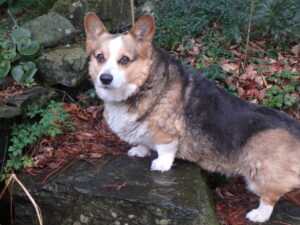
OLYMPUS DIGITAL CAMERA
Daphne mezereum was the registered name of my corgi, Daffy, who passed away on August 25 of this year. Born in 2006, Daffy was my constant companion who was always ready for an adventure – or especially, a meal or snack. When her back legs gave out, she figured out ways to propel herself forward with glee – ignoring the inconvenience, and trying to overcome the pain. Finally, when the pain was nearly constant, and we reluctantly called the vet.
We buried Daffy alongside her cat friend, Winnie, who passed naturally at age 23 in June of this year. And Abby and Stanley and Emily, all good dogs who have passed on and been buried in a quiet shady place on our property. Each had their graves decorated with flowers from the garden. Let’s take a look at some of the plants I grow, and that I used to commemorate Daffy and celebrate her life.
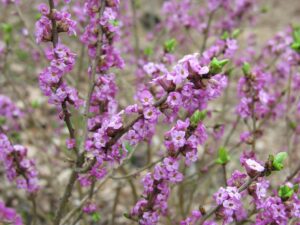
Of course I cut branches of her namesake,
Daphne mezereum or February Daphne. It is a fabulous shrub that blooms in May here in Cornish Flat, displaying pinky-purple fragrant flowers in abundance. It is slow-growing, so easy to maintain. No need to do much pruning – other than stems I cut to force in a vase each year in April.
And I put in her grave a couple of stems from a Harry Lauder’s walking stick shrub. A walking stick seems fitting for a dog that had trouble walking. It’s a curly hazelnut that would not really be good as a walking stick – there are no straight bits. Mine is a variety called ‘Red Majestic’ of the European filbert
(Corylus avellana).
In the spring the leaves are a deep red-purple but develop a greenish tinge as the summer progresses. I have mine in a flower bed, and have been able to keep it to a 6-foot wide and tall tree by annual pruning.
And I sent Daffy off with diamonds. ‘Pink Diamond’, that is. It’s a lovely variety of Hydrangea paniculata. I bought one that is a “standard”, meaning that it came with a straight trunk that had branches grafted on at the 4-foot high level. So it started out as a shrub with some height, and never suffered from the awkwardness common to many hydrangeas that start as multi-stemmed shrubs.
At the bottom of Daffy’s grave I placed boughs from a Canadian hemlock (Tsuga canadensis). This is a native evergreen tree that grows well in sun or shade. In 1972 I dug up several growing wild in a field nearby and planted them as a hedge. They are now 50 feet tall or so. My late sister, Ruth Anne, lived in Canada and loved Daffy fiercely, calling her “the dog of joy”. So these boughs commemorated them both. I no longer promote planting hemlocks because an insect pest, the wooly adelgid, is decimating them – though thankfully not in my area, as yet.
Of the woody plants, the last I placed in Daffy’s grave was a stem from my Bartlett pear. Daffy, always hungry, would gorge on the pears that fell on the ground beneath this tree, so it seemed fitting to put a branch in.
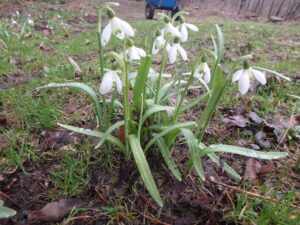
Snowdrops bloom in March and always delight me when they do
I cut fresh perennial flowers for Daphne’s grave, too. Phlox have been gorgeous this year, disease-free and fragrant. Daffy is the only dog I’ve had who noticed flowers. I have a picture of her checking out a vase of tulips. But phlox is in all its glory in sunny beds, so I cut some.
Daffy had a sunny disposition, even at the end when she was in pain, so I included a sunflower. Like Daphne, it was a short one, perhaps ‘Teddy Bear’. There are so many great sunflowers out there, many short and with multiple flowers branching off the main stem. They are easily started from seed. Chipmunks love them when they are just starting, so I grow them in 6-packs until they are tall enough to ignore the rodents. Deer love sunflowers, too, however, when they get bigger.
And roses went in the grave, too. My favorites are the ‘Knockout’ roses. Perhaps because they are not fragrant, they don’t seem to be attractive to the Japanese beetles that can plague old fashioned roses. They are fast-growing, and can reach a height of 4 feet in a couple of months even if all above-ground stems died over the winter. The one I selected for Daffy has had 25 blossoms most of the time this summer.

This tithonia blossom is about 2 inches wide on a 6 foot tall plant with many blossoms
Then we added some Shasta daisies, those wonderful, cheerful flowers with white petals around a central yellow button. My patch of those gets a bit bigger each year in full sun. And Mexican sunflowers (Tithonia rotundifolia), a 6-foot tall orange annual in the daisy or sunflower family. We start lots of these by seed each year, and I am always delighted by the results.
I suppose there were other flowers we picked for Daphne’s last day, though it’s all a bit of a blur. I do know that flowers always lift my spirits, and certainly they needed some lifting that day. But I’m doing better now, and being in the garden has helped. Later this fall I will plant bulbs on her grave – snowdrops. They are the first flowers to bloom in spring, and always bring me joy. And after all, she was the Dog of Joy.
Pushing the Envelope: Bring on Spring!
Posted on Tuesday, March 3, 2020 · Leave a Comment

Snowdrops are the first flowers to bloom for me
On February 24 this year I went to my vegetable garden with a snow shovel. It was a warm, sunny day, and I was ready for spring. Now people say that old timers like me are more patient than young whipper-snappers, but I’m not sure that’s true. We have less time left on the planet, so some of us want lettuce and spinach from the garden sooner.
Obviously I knew that I couldn’t just shovel snow and plant. But I have a nice cold frame, and I wanted to set it on the soil and allow it to melt ice and snow, and get the soil warming up on sunny days for late March planting. I shoveled off about a foot of snow, and put the cold frame in place. An hour later my thermometer inside read 70 degrees!
My cold frame is one I got from Gardeners Supply. It is 8 feet long, 2 feet wide and is made of cedar planks with a polycarbonate lid that is set on an angle. The lid is hinged and can be left up on a stick to vent some heat on a sunny day, or it can be completely opened in summer.
My grandfather always had cold frames to extend the seasons, and he built his own out of planks and old storm windows. I’ve done that, too, but this light-weight and sturdy cold frame was quick and easy to assemble and to store in my barn after use.

This simple cold frame from Gardener’s Supply can be assembled in an hour
The slanted top should face south or east for maximum solar gain. The cedar panel at the front of mine is 8 inches tall, the back is 15 inches tall. That allows morning sun to get in through the slanted top.
I’ve also used my cold frame as a hot box. A hot box is a growing space that is heated by fermenting horse manure. When using the frame as a hot box, I dig a pit 18 inches deep the size of my cold frame and line the hole with 2-inch thick pieces of Styrofoam insulation. That keeps the cold soil from cooling down the manure so much that it stops fermenting. It is important to get horse manure that is from a pile that is already hot and fermenting. Too much sawdust or straw will inhibit fermenting.
Once the pit is insulated, I fill it with a 12-inch layer of fermenting horse manure in the bottom and then 6-inches of topsoil. I find that seeds planted in the soil germinate quite quickly due to the heat. Most seeds will not germinate in cool soil and germinate quickly in warm soil.
If you use a cold frame, I recommend planting cold tolerant plants. A cold frame will not protect tomatoes, peppers, or other frost-sensitive, heat-loving plants in early spring. Spinach, lettuce, mache (also called miner’s lettuce), cabbage and kale are good choices.
When selecting lettuce seeds for planting, look for ones that are recommended for early season planting. Johnny’s Selected Seeds lists 7 named varieties of lettuce for early season use including Vulcan (a red leaf) and Sparx (a Romaine). Fedco Seed Coop recommends Black Seeded Simpson as the earliest and most popular of the loose-leaf varieties, and I agree that it is a very good one, and very cold tolerant. Read your seed catalog carefully when selecting early season varieties.
Another layer of protection at night is good for plants growing in cold frames in late March or early April. If the temperatures are said to be dropping into the low twenties, you should cover your plants with a layer of row cover or Reemay.
Row cover is a thin synthetic agricultural fabric that will hold in some heat at night. It is also used to keep insects off plants like cucumbers later in the season. Sunshine will pass through row cover, and it allows plants to breathe, so you don’t have to remove it every day if there is a week of cold weather. It does keep a little of the suns UV rays from reaching the plants, but the transmission rate is usually on the package. (The lower the number, the less UV rays reach the plants, but the more it holds heat).
If you are tired of winter but not ready to commit to a cold frame, there other activities for pushing the season forward. You can cut stems of early blooming plants like forsythia, February daphne ( Daphne mezereum) and pussy willows and bring them indoors. Place them in water and put the vase on a sunny window sill. In a week or two you will be rewarded with blossoms.
Other blooming trees suitable for forcing are magnolias and apples. Not every stem cut from an apple tree will bloom: look for branches that have short spurs on them. These are called fruit spurs, and each one can produce both leaves and blossoms. Young fruit spurs will only produce leaves, so look for older, gnarly spurs that are usually 3 to 6 inches long. Those straight water sprouts that shoot up vertically don’t normally have blossoms. The furry magnolia flower buds are obvious.
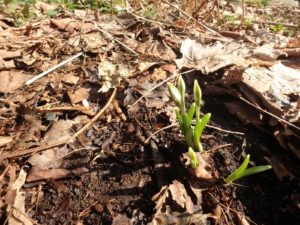
Snow drop buds are up on March 3
One last thing you can do, if you know where you have snowdrops or crocus planted, is to shovel snow off the bed. That will allow them to bloom in early March, as they will push up through frozen soil. And if you don’t have any snowdrops, pay attention to the places where the snow melts off first. Mark the location with a plant tag, or take a photo, and next fall plant snowdrops for early flowers. Glory of the snow, scilla, winter aconite and early crocus are all good early bloomers. And spring will be here before you know it!
Henry may be reached at PO Box 364, Cornish Flat, NH 03746 or at
henry.homeyer@comcast.net. He is the author of 4 gardening books, and is available for speaking to your garden club.
The Spring Bulb Flowers
Posted on Tuesday, April 16, 2019 · Leave a Comment
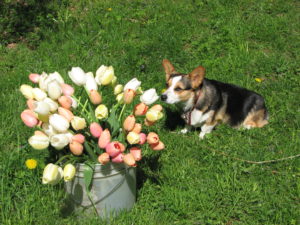
My dog Daphne
Now is the time to decide where you should plant bulbs next fall. Here’s what I do: I wander around my property each year in the spring to see what spots are bare of bulb flowers. I bring along those white plastic markers used for labeling, and write “add crocus here”, for example. Then in the fall, when it’s time to plant more bulbs I don’t have to rely on my memory to know what to plant, and where.
When planting bulbs, I label what I‘ve planted. That way I’ll see what has performed well, and remember to buy more of the same. For example, I’m always eager to get color in the garden at the same time that the white snowdrops bloom. Two purple-blue bulbs bloom about the same time: Glory-of-the-snow is one plant that overlaps with snowdrops, but is a bit later, as is scilla.
This spring I saw a crocus that was labeled ‘Blue Pearl’, that is blooming with my snowdrops – and before those other two. So I’ll buy 100 of those for fall planting. I bought them at Brent and Becky’s Bulbs– I know because they include tags with each bag of bulbs. And I can order them now for delivery then.
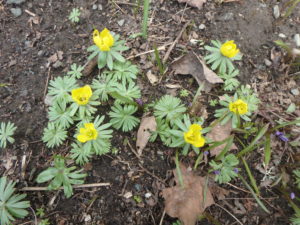
These winter aconite self-seeded
This year I am delighted to see that the winter aconite that produced seed 2 years ago is going to bloom. Last year I recognized the leaves, but it did not produce blossoms. It is a very early bright yellow flower that has one-inch wide, six-petaled flowers. I’ve grown it before but lost it to cold or rodents or poor drainage, and re-planted in other spots. This new patch will give me 50 or so “free” flowers.
I tend to blame bulb failure on drainage problems, not rodents. I mix in lots of compost at planting time and favor hillsides, which helps with drainage. Wet soil is hard on bulbs. Our cats tend to keep rodents away. South facing hillsides are great for early bulbs as the snow melts off weeks earlier than north-facing plots, and drain well.
A bulb plant that I’ve considered fussy is a low-growing iris, Iris reticulata. It is just a few inches tall and has medium-sized blue, purple or (sometimes) yellow flowers. Doing some research I found out why I thought they are fussy: after they bloom, the bulbs divide, producing several little bulblets. These won’t bloom for a few years. So I need to plant some every year until I have a mature colony of them. I also read that they like soil that dries out well in summer, such as in a rock garden or sandy hillside.
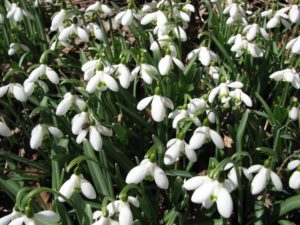
Snowdrops are the first flowers to bloom for me
My lawn is full of snowdrops that have planted themselves. I assume that they produce seeds that wash into the lawn during summer rains. The bulk of my snowdrops are planted on a hillside above the lawn. But you can plant early spring bulbs in the lawn, too. Just don’t plant daffodils or anything with large leaves because you won’t be able to mow the lawn where they are growing until the leaves yellow and dry off – around July 4th. Bulb plants need to re-charge their batteries, if you will, by getting sunshine and storing energy.
Little bulbs like snowdrops, crocus and grape hyacinths have short leaves that disappear early and won’t disrupt your early mowing. You can always set the lawn mower blades high to protect the leaves if they are still green when you need to cut the lawn.
Grape hyacinths (Muscari spp.) are great little flowers that come in many different shades of blue and purple. I’ve planted many dozens in my day, but find they tend to lose vigor and disappear with time. So I plant them again. Whenever I see grape hyacinths for sale in pots at the grocery store, I buy them. I enjoy them immensely in the house. Later, when the soil is thawed, I plant them outside. I keep the pot in a cool space indoors, as if they get too warm, they flop over.
Tulips I treat like annuals. Why? They do well the first year, but quickly go downhill or disappear in subsequent years no matter what I do. I plant 100 most years in a bed that I reserve for them. Later I plant zinnias in the same bed, so I don’t bother to coddle them. My corgi, Daphne, keeps the deer away.
Daffodils are slightly poisonous to deer and rodents, so they aren’t eaten – and can bloom for years. You can plant them in open woodlands and they will do fine. By the way, if you forced paperwhites this winter, don’t bother planting them outdoors – they’re not hardy here.
I’ve been paying attention to bulb flowers at least since I was 9 years old. I recently found entries in my diary that tell me so. My entry for March 7, 1956, in its entirety was this: “Spring is getting here at last the snow drops are in bud + will bloom in a few days.” Then on April 5 I wrote,” Today our first crocus was in bloom it is very pretty.” As a guy who makes his living writing, I no longer keep a daily journal. I tend to document my life now with a digital camera – and this column. Thanks for keeping me writing!
Henry lives and gardens in Cornish Flat, NH. You may reach him at henry.homeyer@comcast.net. He is the author of 4 gardening books.
Gardening: The Slowest of the Performing Arts
Posted on Monday, March 19, 2018 · Leave a Comment
March has been ferocious. None of this “In like a lion, out like a lamb” business. The entire month has been a Tyrannosaurus Rex, if you ask me. I’ve done more roof-shoveling this month than I usually do in a year. My poor snowdrops, usually showing me their noses in early March, are still deep in snow. Sigh. But spring will come. It always does.
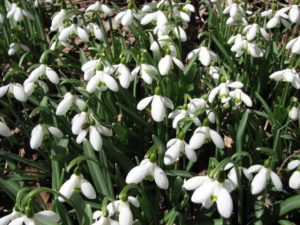
Snowdrops
Snowdrops, my harbinger of spring, are best planted on a south-facing hillside. That way the snow melts off early, and allows them to push up through the frozen soil. Unlike tulips, their little white flowers look downward, so one must bend over and tip the blossoms up to see inside, which is always the most interesting view of a flower – all those stamens and pistils.
My snowdrops have multiplied over the decades. I don’t know if they move by seed, or if little rodents dig them up and move them around. I suspect it is by seed since they tend to move downhill into the lawn. Fortunately, they get all the sunshine they need to re-charge their batteries by the time I’m ready to mow the lawn. Daffodil leaves, on the other hand, don’t dry up until July, so I don’t plant them in the lawn.
Glory of the snow (Chionodaxa lucilae) is another small early bulb plant that will appear as soon as my snow disappears, and it has multiplied nicely over the years, too. I have it light blue, white and pink. Unlike snowdrops, the blossoms open with their faces up towards the sun – and us.
Scilla siberica, or squill, comes out just a few days after my glory of the snow and has a very intense purple color. Just a couple of inches tall, these small beauties look down, like the snowdrops. These do not multiply quickly, though their clumps or clusters do get more robust over time.
Bright yellow, school bus yellow, I associate with daffodils, and I have plenty of those that bloom in April and May. But before even the earliest are some short yellow blossoms of winter aconite (Eranthis hyemalis). I just learned that they are related to buttercups, which makes sense to me, given their color and flower shape.
Aconite are marginally hardy for me in Zone 4, but last spring I had many tiny ones, clearly first-year plants that developed from seed. I wonder if they will return and bloom for me this year. Such questions will get me outside and in the garden every day, should I ever get old and frail.
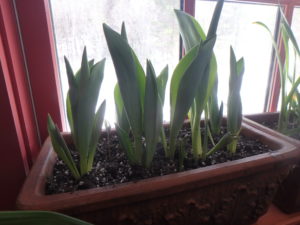
Tulips growing on the windowsill on the first day of spring
Many gardeners have given up on tulips because they are so tasty: to rodents that eat the bulbs, and to deer that consume the buds, blossoms and leaves. Not only that, most gardeners find tulips don’t return, year after year. I think of them as annuals since in year two I get half the number of blossoms I did in year one, and then only half of those come back to bloom in year three. No matter, I love them and plant them.
There are solutions to the tulip dilemma. First, I plant plenty each fall in clay pots and store them in my cold basement. Then, after 4 months of cold storage, I bring the pots into the warmth of the house and they bloom on the window sill. Right now I have some budding up, getting ready to bloom.
At the end of President Clinton’s tenure in the White House I got to interview the White House gardener, Dale Haney. The gardeners had just planted many thousand tulips, a pink one called Hilary Rodham Clinton! I always wondered if the Bush family asked the name of that one, and how President Bush felt about seeing Hilary tulips outside the Oval Office windows, waving at him in the breeze.
.
The White House grounds, I observed, were not only served by many gardeners, but occupied by many large, fat, lazy gray squirrels. I asked Mr. Haney about them. First, he explained, that our tax dollars paid for hundreds of pounds of sunflower seeds to feed the squirrels. A well-fed squirrel is less likely to dig up tulips, he said.
He also explained that the gardeners laid down chicken wire above the bulbs – but an inch or two below the soil surface. Thus if an unusually ambitious squirrel decided to lunch on a Hilary, it would be thwarted by the screening. I’ve tried that, but it’s a lot of work – and my little corgi and two aging cats seem to deter squirrels from digging up any tulips I plant outdoors.
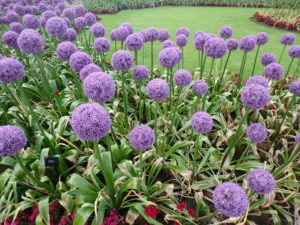
Alliums at Kew Gardens
Alliums are bulb plants that vary considerably in size and look according to the species or variety. They’re in the onion family, so not eaten by critters. I was amazed by all the diversity I saw last spring in London at the Chelsea Flower Show, and at Kew Gardens.
I’ve always had a few big ones outdoors, but last fall I planted some in pots to force indoors, as one spectacular variety I simply had to have, Allium schubertii, is only hardy to Zone 6 and would not survive outdoors here. I bought plenty of others that are hardy here in Zone 4 and can’t wait to see them perform.
Gardening – indoors or out – really is the slowest of the performing arts. Plant something, wait, hope. The anticipation, for me, is almost as important as the performance.
Henry is a UNH Master Gardener and the author of 4 gardening books. Reach him by e-mail at henry.homeyer@comcast.net.
When – and How – To Plant Bulbs for Spring Blossoms
Posted on Tuesday, September 12, 2017 · Leave a Comment
When the soil drops to 60 degrees Fahrenheit at proper planting depth, you can plant bulbs. You’ll need a soil thermometer, but that’s a handy device anyway – they’re useful in the spring to see if the soil is warm enough to plant tomatoes or eggplants without making them recoil in shock like a sixth grader wading into a chilly pond.
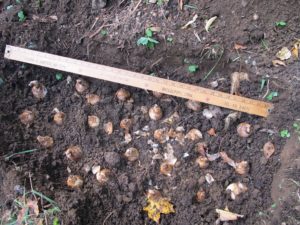
Daffodils planted in a 36-inch diameter hole, about 6 inches deep and 3 inches apart
Soil thermometers are similar to the probes sold for testing turkey temperatures in the oven. A steel probe with a dial on top. You just poke it into the soil and wait a moment. Sometimes I put a pieces of tape at different locations: 3 inches for crocus, 6 inches for daffodils, 8 inches for tulips. Then I can easily see the temperature without digging. They are available at garden centers, or on-line.
Why sixty degrees? In soil warmer than that, your bulbs may sprout, thinking it’s spring. That’s not lethal, but not desirable. You do want the soil warm enough so that the bulbs will establish roots now, getting them ready for action in spring and holding them in place against frost heaves.
I tested the soil in a few places recently to see if it’s ready to plant. In full sun in my vegetable garden, the soil was slightly above 60 degrees, but in a shady flower bed the soil was in the high fifties. And down 8 inches it was 4 or 5 degrees cooler. I’ll plant crocus later, as the soil at crocus depth (3 inches) is warmer than deep down.

Snowdrops in bud on March 1
I bought my house 47 years ago, and I’ve been planting bulbs most years ever since. Most places suitable for bulbs, have bulbs. So this year I shall plant some in the lawn. Not daffodils, as the foliage can’t be cut back until July, and that would keep the lawn looking unkempt. But I could plant small bulbs like crocus, snowdrops or scilla. Their foliage dies back early enough that I’ll be able to mow the lawn when needed without compromising the bulbs. I’ll plant them by poking holes in the lawn with my CobraHead weeder (www.CobraHead.com).
Some years ago I was visiting a garden in Wales. The gardener had a bucket of tennis balls, and was tossing them onto the lawn. “What in the world are you doing,” I asked. He explained that he wanted to plant bulbs in a random pattern. Wherever a ball landed, he planted a bulb. Maybe I’ll try that.
I like to consider tulips as annuals. They do come back in year two at about 50 percent of year one, and year 3 is usually about 50 percent of that. So in general I buy 100 tulips, plant them all in the vegetable garden, and enjoy a big burst of color. I cut most and use in the house, or as gifts. I plant right over them after blooming, not worrying at all if they survive. A few will pop up in the lettuce the following year.

Daffodils are deer-proof
Daffodils are not attractive to rodents or deer as bulbs or as flowers. In fact, they are vaguely poisonous. But tulips are tasty to critters. Last year I planted a few cloves of garlic in with my tulips to repel rodents. I don’t generally have trouble with deer – I have a ferocious corgi who scares them off. They think she is a wolf, I suppose.
If you have deer problems, you probably will want to plant tulips in big swaths and then surround them with a temporary fence before they bloom. Even a 4-foot chicken wire fence should deter them, I think. There are repellents, of course, but I’ve never used any with tulips.
I have 3 books in my personal library about bulbs. All say to plant tulips and daffies 6 inches apart. I don’t. It uses too much space. I plant them three inches apart, and they do fine.
There are two keys to success when planting most spring-blooming bulbs: First, plant in full sun. Yes, in principle, you can plant daffodils in the woods if there are no evergreens and they will get enough energy from the sun before the maples leaf out. But they will do better in a sunny border. Root competition from trees diminishes their vigor.
Second, plant bulbs in soil with good drainage. Soggy soil is a death knell to most bulbs. If you have a heavy clay soil that holds water, plant your bulbs on a slope. Toss away half the soil you dig out and mix a light, fluffy compost with the other half. Dig deeper than needed, and fill with that same fluffy mix.
I don’t regret a penny I’ve spent on bulbs. Yes, some can be expensive. Yes, some don’t perform well. But by the end of a long New England winter I am so ready for blossoms I am willing to do almost anything (short of a deal with the devil) to get flowers blooming outdoors.
So go buy bulbs now. Later, when it’s time to plant, the best ones will be sold out. Start at your local garden center and look on-line for a few fancy things. Do this every year, and you’ll be delighted!
Is it okay to prune shrubs now? Learn which ones can be pruned by reading Henry’s blog post at https://dailyuv.com/news/920694. His e-mail address is henry.homeyer@comcast.net.
Planting Bulbs
Posted on Tuesday, October 11, 2016 · Leave a Comment
For the past 3 decades or more I‘ve planted the bulbs of spring-blooming plants every fall. Some years it was just a couple of dozen, other years more than 100. October is a good time to plant them, though one year I was traveling and didn’t plant my bulbs until November. I had to shovel snow off the ground to plant bulbs that year.
I plant bulbs because it gives me something to look forward to during the depths of winter. I dream of clouds of purple scilla and white snowdrops, hillsides awash with golden daffodils, vases of tulips on every flat surface of the house. For the price of dinner for two at a moderate restaurant, you can buy 100 bulbs or more – and now is the time to do so.
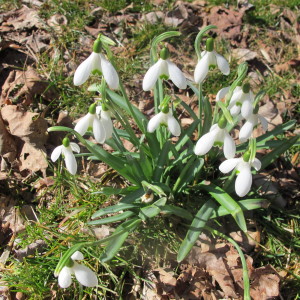
Snowdrops
I love snow drops (Galanthus nivalis). Granted, they’re small and their blossoms hang down so they’re hard to see their faces well, but they’re the first to bloom, often coming up through frozen soil in early March. I transplanted fifty or a hundred from my childhood home in Connecticut 35 years ago, and by now I have uncountable numbers. They sneak into my lawn, popping up far from where I put them. I don’t know how they move around – perhaps by seed, or perhaps with the help of those otherwise pesky rodents, the squirrels.
Other early bloomers are scilla (Scilla siberica) and glory-of-the-snow (Chionodaxa spp.), both blue to purple (glory-of-the snow also comes in pink and white). Like snowdrops, they’re small – so they need to be planted in groups of 50 or more to really look good.
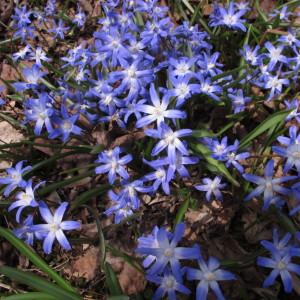
Glory-of-the-snow
Crocuses also can bloom early, though I’ve never had any as early as my snowdrops. There are at least 80 species of crocus and many hundreds of colors, but most garden centers and grocery stores just offer a couple of species and three colors – large purple, white or yellow. For that reason I study the bulb catalogs to explore other possibilities.
The bulb company McClure and Zimmerman has an excellent array of crocus, but I find their website awkward, so it is probably worth calling for a print catalog (800-546-4053). Brent and Becky’s bulbs is a family run business that is also excellent (www.brentandbeckysbulbs.com or 804-693-3966). You may be surprised to see that crocus bulbs can cost over a dollar each, but the rarer varieties are pricey.
Daffodils are wonderful, in part, because animals don’t eat them, not rodents, not deer. There are hundreds of kinds of daffodils in 13 major categories. Some bloom early, some late. Some produce one flower per stem, others several. I continue to explore the daffodils each year by buying some new ones- and you should, too.
If you grow hostas, you know that their leaves don’t get very big until June or July. I like to plant clumps of daffodils between clumps of hosta so that their leaves will cover the foliage of the daffodils after they bloom.
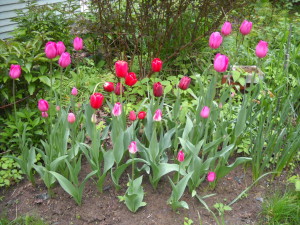
Tulips
In recent years I have been buying 100 tulips and planting them in one bed. I like them as cut flowers – and they make terrific gifts. I like having enough to pick dozens at a time, and having them all come into bloom at once.
Most tulips, for me, tend to run out of energy and get fewer in number as the years pass, so now I consider them annuals. I dig a hole about 4-5 feet long and 2 feet across and plant all 100 in one place. Then, once they are done, I cut off the foliage and plant annual cut flowers like zinnias for summer enjoyment. Wasteful? I suppose, but life is short, and I love them so.
I’ve found that my CobraHead weeder (www.CobraHead.com or 866-962-6272) works well for planting individual small bulbs like snowdrops or crocus in the lawn. I just push it into the soil the appropriate depth, pull back to create a small slice in the soil, take out the tool and drop in a bulb. The slice in the lawn closes up easily with a push of my hand.
My last bits of advice on planting bulbs: add some slow-release organic fertilizer (or bulb booster) at planting time, and mix plenty of compost into the soil. Bulbs need good drainage to thrive, and compost helps with that. If you are worried about rodents, you can sprinkle them with cayenne pepper, though its effect only lasts for a year.
Lastly, buy plenty of bulbs. Come spring, you’ll revel in their beauty and enjoy them much more than that ephemeral dinner for two you might skip now in order to afford their cost.
Read Henry’s blog about how to save your dahlia tubers for next year at https://dailyuv.com/news/862147. While there you can up for an email alert every time Henry posts his blogs.
The Spring Bulb Flowers
Posted on Wednesday, April 16, 2014 · Leave a Comment
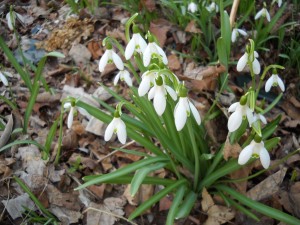
Snow drops in April
I’ve been paying attention to snowdrops and crocus since I was 9 years old – I recently found entries in my diary that tell me so. My entry for March 7, 1956, in its entirety was this: “Spring is getting here at last the snow drops are in bud + will bloom in a few days.” Then on April 5 I wrote,” Today our first crocus was in bloom it is very pretty.” I still pay attention to them, and generally note when they come into bloom. Now is the time to decide where you should plant bulbs next fall.
Here’s what I do. I wander around my property each year in the spring to see what spots are bare of bulb flowers. I bring along those white plastic markers used for labeling, and write “add crocus here”, for example. Then in the fall, when it’s time to plant more bulbs I don’t have to rely on my memory.
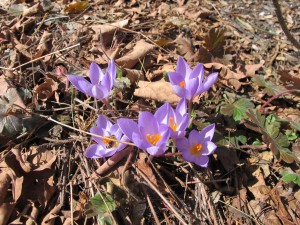
Early crocus
When planting bulbs, I label what I‘ve planted. That way I’ll see what has performed well, and be able to buy more of the same. For example, I’m always eager to get color in the garden at the same time that the snowdrops bloom. Glory –of-the-snow is one plant that overlaps with snowdrops, but is a bit later, as is scilla. This spring I saw that a crocus I planted last fall, ‘Blue Pearl, is blooming with my snowdrops – and before those other two. So I’ll buy 100 of those for fall planting. I bought them at Brent and Becky’s Bulbs– I know because they include tags with each bag of bulbs.
Writing this in early April, I haven’t seen any of my winter aconite appear, though I would have thought they would be up by now. It is a very early bright yellow flower that has one-inch wide, six-petaled flowers. I’ve grown it before but lost it to cold or rodents or poor drainage. I’m still optimistic that it will show up.
I tend to blame bulb failure on drainage problems even though I mix in lots of compost at planting time and favor hillsides. South facing hillsides are great for early bulbs as the snow melts off weeks earlier than north-facing plots. But rodents might be the culprits, too.
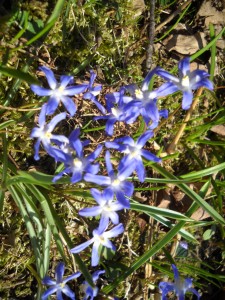
Glory of the Snow early April 005
A bulb plant that I’ve considered fussy is a low-growing iris, Iris reticulata. It is a lovely iris that blooms near the ground level and has medium-sized blue, purple or (sometimes) yellow flowers. Doing some research I found out why I thought they are fussy: after they bloom, the bulbs divide, producing several little bulblets. These won’t bloom for a few years. So I need to plant some every year until I have a mature colony of them. I also read that they like soil that dries out well in summer, such as in a rock garden or sandy hillside.
My lawn is full of snowdrops that have planted themselves. I assume that they produce seeds that wash into the lawn with early summer rains. The bulk of my snowdrops are planted on a hillside above the lawn. But you can plant early spring bulbs in the lawn, too. Just don’t plant daffodils or anything with large leaves because you won’t be able to mow the lawn where they are growing until the leaves yellow and dry off – around July 4th. Bulb plants need to re-charge their batteries, if you will, by getting sunshine and storing energy.
Little bulbs like snowdrops, crocus and grape hyacinths have short leaves that disappear early and won’t disrupt your early mowing. You can always set the lawn mower blades high to protect the leaves if they are still green when you need to cut the lawn.
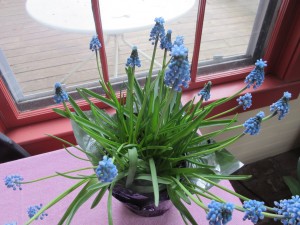
Grape hyacinths
Grape hyacinths (Muscari spp.) are great little flowers that come in many different shades of blue and purple. I’ve planted many dozens in my day, but find they tend to lose vigor and disappear with time. So I plant them again. This spring I bought a pot of them at a garden center and have been enjoying them immensely in the house. Later, when the soil is thawed, I’ll plant them outside. I keep the pot in a cool space indoors, as if they get too warm, they flop over.
Tulips I treat like annuals. I plant 100 most years in a bed that I reserve for them – and later zinnias. If I had depended on bulbs planted in 2012 for this year, the number of blooms might be just 50, and maybe 25 the following spring. So I don’t bother to coddle them. In fact, I often pull the flower stem instead of cutting it, as I can get an extra 2-3 inches of stem for my vase, and I love tall tulips. I compost the spent bulbs. I find that adding a few pennies to the water in the vase helps the tulips to last longer before losing their petals, or opening if picked in bud.
Daffodils are slightly poisonous to deer and rodents, so they aren’t eaten – and can bloom for years. You can plant them in open woodlands and they will do fine. I grew up with daffodils planted along paths in our woods, and I still delight in the memory of them. By the way, if you forced paperwhites this winter, don’t bother planting them outdoors – they’re not hardy here.
Bulbs are a great investment. Most come back year after year, bringing me pleasure each year before the garden gets going.
Henry Homeyer is a gardening coach living in Cornish Flat, NH. His Web site is www.Gardening-Guy.com.
Early Spring Chores
Posted on Wednesday, April 9, 2014 · Leave a Comment
Spring finally seems to be coming to Cornish Flat – about a month late, this year. My snowdrops are just starting to bloom and large patches of snow are still on the lawn and garden – though there are bare spots. I really want to get outside and start cleaning up the yard and garden beds, but will try to hold myself back until things have dried out.
Why is it important to wait before doing much gardening? It’s all about soil structure. Soil is made up of ground rock, organic matter and air spaces. The mineral component is about 45%, organic matter can be from 1% to 10% or more, and the rest consists of air spaces. That last component is as important as the first two.
Plant roots that we can see when we dig up a weed or plant a shrub are only a part of the entire root. The parts of the root that absorbs water, oxygen and minerals are so fine that we cannot see them. They are called root hairs, but they are even finer than human hair, microscopically fine. And there are lots of them. Most plants have branch roots that spread out and branch again and again. Root hairs are short protuberances attached to those branching roots. But fine roots cannot push through packed soil as easily as through fluffy soil. The total length of root tissues in a single rye plant is around 380 miles.
As you know, if you walk on soggy lawn you leave foot prints. That means that you have squeezed air out of the soil and compacted it – making it all the harder for roots and root hairs to extend and thrive. Not only that, green plants get their oxygen from the soil via their roots. If the oxygen is squeezed out, plants can’t get it.
So what can a gardener do? Wait. Don’t walk on your lawn if you see footprints or hear a squish. Don’t rake winter debris from the lawn while the lawn is still dormant. If you do, you risk pulling up the grass, roots and all. And stay out of flower beds even later into the spring – they are more susceptible to compaction than your lawn.
So what can you do in early April? Clean and sharpen your tools, including the handles. I have a potato hoe, a 5-tined rake-like tool that has been in my family for over 50 years. It has its original wood handle, which is still in perfect condition – even though I use it for weeding and soil prep every week, often every day, all summer. How is that possible? I try to oil the handle every year either in the fall or the early spring. And I don’t leave the tool outside in the sun or rain. No matter how tired I am at the end of the day I walk the potato hoe back to the barn before I go to the house.
To clean up a wooden handle, first I use fine steel wool (or a green scrubbie) to polish up the handle and remove any rough spots. Then I apply a coat of boiled linseed oil with a brush or rag. I let it soak in for a few hours, then rub off any excess. Or if the oil soaks right in, I might even apply a second coat. The steel tines I clean with steel wool and apply a light coat of sewing machine oil.
This year I need to oil the wood on my wooden wheel barrow and tighten up all the bolts. One of my first memories in my life is of my Grampy picking me up, plunking me down in his wooden wheelbarrow on a pile of weeds, and racing us back to the barn ahead of a fast-approaching thunderstorm. I might have been just two years old. The ride was bumpy – there was a steel-rimmed wooden wheel – but it was exciting!

Wooden wheelbarrow
Photo Credit: Spring Valley Woodworking
Unfortunately that wooden wheelbarrow disappeared after Grampy went off to the great garden in the sky. But many years later I tracked down an Amish woodworker in Pennsylvania, Ike Lapp, who still makes wooden wheelbarrows and got myself one. It’s pretty much the same wheelbarrow I remember my grandfather using. When I finished assembling it I pushed it across the lawn for a test drive and it made the same squeak that my grandfather’s wheelbarrow did.
I called Ike Lapp at his home in Gordonville, PA recently. He is old order Amish, so does not have a phone in his house or workshop. Instead he has a phone and answering machine in a separate 4-foot square building in a field. (He checks messages once a day and calls customers back. He’s at 717-355-9366 717-355-9366). He told me he is still making the wheelbarrows and in addition to mine, a large premium grade wheelbarrow for around $300, he has smaller ones, and some in “rustic grade”. He does not have a web site, but you can see his wheelbarrows at www.lehmans.com.
717-355-9366). He told me he is still making the wheelbarrows and in addition to mine, a large premium grade wheelbarrow for around $300, he has smaller ones, and some in “rustic grade”. He does not have a web site, but you can see his wheelbarrows at www.lehmans.com.
Later, when your ground has dried out and you are raking and weeding flower beds, try to reach in with your rake, keeping your feet out of the beds. If you must walk in flower beds, bring along a couple of short planks. Place them in the flower bed and step on the boards to distribute your weight. Or if you are not worried about what the neighbors will say, you could wear your snowshoes. After the winter we’ve had, that seems appropriate!
Henry Homeyer is a gardening consultant and the author of 4 gardening books. His web site is www.Gardening-Guy.com.
Hastening Spring
Posted on Wednesday, April 17, 2013 · Leave a Comment
I don’t know about you, but I’m tired of cold, raw, rainy days. And I really don’t want any more snow or slush. We’ve had some good warm and sunny days, but I know I shouldn’t expect them consistently yet. There are things I do to make me feel like spring and summer are on the way, even when it’s sleeting outside.

Forsythia
A couple of weeks ago I picked some stems of forsythia, that old fashioned shrub that displays mounds of bright yellow flowers long before most other shrubs bloom. By now these seemingly lifeless branches are loaded with flowers in full bloom on a sunny windowsill in my house.
The key to forcing forsythia is to pick twigs that grew last year – young, vigorous stems – that are loaded with pointy buds about a quarter of an inch long. These are the flowers buds. Cut stems 18-24 inches long and put in a vase on a sunny windowsill. It took less than a week for mine to bloom.
I pick flowers now, too. Right now I only have two things in bloom outdoors: snowdrops and glory of the snow. Snow drops are demure, understated white flowers that only grow 4-8 inches tall, and tend to stay on the shorter end of that range. I have a thousand or more in bloom now because I started transplanting them from my parents’ gardens back in the 1980’s and they have naturalized and spread by seed. They have spread out into my lawn, blossoming in clumps of a dozen or so.
Glory of the snow (Chionodaxa spp.) is another great early spring bloomer. I have the classic blue/purple ones as well as some less common pink ones. These diminutive beauties look up, showing their open throats, which are white and contrast nicely with their blue petals. Many gardeners ignore the small bulb plants, focusing on daffodils and tulips which are more dramatic when they bloom. But I like early blossoms, and have planted plenty of these small wonders, too. The time to plant is in the fall, September and October.

Snow Drops & Glory of the Snow
Now is the time to order spring bulbs – I know where the holes are in my planting space, and I know what I need to order. So I called Becky Heath, co-owner of Brent and Becky’s Bulbs in Gloucester, VA to order up more spring bulbs to plant next fall (www.brentandbeckysbulbs.com or 804-693-3966). I asked for the very earliest of crocus, as I mostly have late-blooming ones. Becky suggested ‘Blue Pearl’ and “Blue Bird’ (both varieties of Crocus crysanthus) as good early bloomers, and a species called Crocus tommassinianus.
I gave Becky my credit card info and asked her to fill up a $50 order with anything nice that is early. Later that day she emailed the details of the order which included some winter aconite (Eranthis spp.), a nice low yellow flower, and 2 species of Scilla, great deep purple flowers. I have both, but not enough. They will ship bulbs in September, but for now I will just mark the spaces where they should go with tags. Brent and Becky’s is one of the few remaining family-owned bulbs companies, and I like to support any family-run business that I can.
Pussy willows are starting to appear along my stream, and I will go pick some this week. The gray furry “pussies” are actually the flowers of a type of willow. If you pick them when still closed up, put them in water to get them to open. If they look fine when you pick them, just place them in a dry vase. They will not change in appearance if you keep them dry. In water they will go through their life cycle, producing yellow pollen and dropping it on your table.
If you planted tulips last fall, the foliage should be showing by now. Deer love tulips, and some of my gardening friends have given up on them because of the deer. My suggestion? Put chicken wire teepees around clumps of tulips now, and keep them in place until after they have blossomed. And pick the blossoms when they are just about to open up. Most of us spend more time in the house than in the garden, so having cut flowers indoors makes sense to me.
When I shopped for groceries recently a got a nice slump of daffodils in bud, 10 stems for $3.99. I have daffies coming along outside, but I want some now. But store daffodils can be iffy. Sometimes they don’t open up, or appear dehydrated and wrinkly. You are always sure to get good flowers from a florist, or from a store with a good floral department. In my experience, big grocery stores don’t always have great ones. It is always important to cut off ¾ of an inch of stem and put in water as soon as you get home.
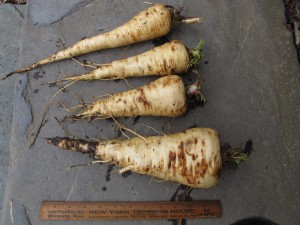
Parsnips
Lastly, I know summer is coming when I eat my first fresh garden vegetables. This year that was on April 11, when I dug some parsnips. Parsnips look like big white carrots, and are delicious after a winter in the ground, getting sweeter. I boil them, then serve with new maple syrup, raisins and walnuts. Spring is on the way!
Henry’s website is www.Gardening-guy.com. You can reach him at henry.homeyer@comcast.net or P.O. Box 364, Cornish Flat, NH 03746.
Planting Bulbs
Posted on Wednesday, October 3, 2012 · Leave a Comment
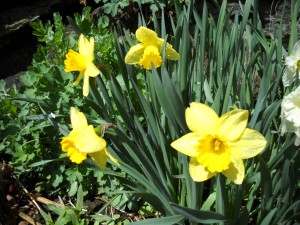
Daffodils
One of my very favorite gardening activities is planting bulbs on a sunny, crisp fall afternoon with Monarch butterflies flitting around and colorful leaves swirling in the air. Each year I plant anywhere between 50 and 300 bulbs and have done so for decades.
I accept that not every bulb I buy is going to last forever. I buy 50 to 100 tulips most years, and consider them annuals because they lose vigor each year, most disappearing after just a few years. I was at a garden center recently and bought 50 mixed tulips for $22. I planted them in one big clump, shoulder-to-shoulder, and will delight in them when they appear. I like tulips as cut flowers and give them away to friends who need a pick-me-up.
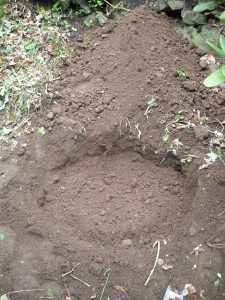
Hole ready for planting bulbs
Yes, I know that rodents and deer like tulips. In my experience, squirrels dig up bulbs in the fall right after you plant them. They see the fresh, soft earth and say to themselves, Oh Boy! Treats! You can help to keep them from digging up the bulbs by laying chicken wire over the bed, and then covering with chipped branches or mulch of some sort. Not that a determined squirrel couldn’t get to them, it’s just my belief that squirrels are relatively lazy, and there’s plenty of other stuff to eat.
Back at the end of the Clinton era at the White House I got to interview the White House gardener. Gardeners there were busy planting hundreds – perhaps thousands – of a yellow tulip that someone thought Mr. Bush (elected, but not in office at the time) would enjoy. It was called the Hilary Rodham Clinton tulip, and I have never found it for sale, but I like the idea: gardening with giggles.
Anyhow, the Rose Garden is full of big fat gray squirrels. I asked Dale Haney, the gardener, how they dealt with the squirrels, and he told me about the chicken wire technique and one other. Your tax dollars are (or were then) at work buying 50 lb bags of corn. That’s right, they feed the squirrels, keeping them fat and happy, and the squirrels pretty much leave the gardens alone. If you try that approach, please don’t sue me if that only serves to invite all the neighbor squirrels to your yard. It just might.
Deer can be a problem when tulips are ready to bloom. You can repel them by using repellents made for the purpose, available at garden centers. Bobex is one particularly nasty smelling one that they hate. I have sprayed it on shrubs, but if you want to bring tulips into the house, I wouldn’t spray it on the flowers themselves, but around them. It loses its disgusting rotten egg-based smell after 2 to 3 days for us, but lasts much longer for deer.

Planting bulbs
Bulbs do best in rich, well drained soil. If you have heavy clay, it will stay wet and may rot some of your bulbs. If that is the case, dig a little deeper hole, and put a two-inch layer of compost in the bottom. I never plant bulbs one at a time. I always dig a hole big enough to hold at least a dozen bulbs, and plant them in a mass. It is much more dramatic, come spring.
According to the International Daffodil Register, there are 12 divisions (classifications) of daffodils based on physical looks and genetic background, and one last division based on botanical names only. All are mildly toxic if eaten, so rodents and deer leave them alone. The range of colors and flower type is truly mind-boggling. Go to your local feed-and-grain store or garden center to check out what is available. If you really want the unusual daffies, you may have to go on-line to a company like Brent and Becky’s or McClure and Zimmerman.
I like to plant early, mid-season and late-blooming daffodils, and read the labels carefully when buying to see their bloom season. One trick to keep in mind next spring is this: cut the spent flowers off after blooming, so the plants do not waste energy making seeds. But don’t cut back the foliage until it turns brown. The leaves are “re-charging” the bulbs. I like to plant clumps of daffies between clumps of hostas – the hosta leaves hide the daffodil foliage after blooming.

Snow drops in April
Get adventurous when you plant this year. A great early summer bloomer is giant snowflake (Leucojum aestivum) which looks like a snowdrop on steroids. These lovelies are 12 or more inches tall and are nice cut flowers. Snowdrops, of course, are essential to any garden. If you plant them on a south-facing hillside, you should get blossoms in early March unless they are planted where snow slides off the roof.
So get outdoors and plant bulbs. You’ll be rewarded with blossoms just when you need them most – after the dreariness of winter.
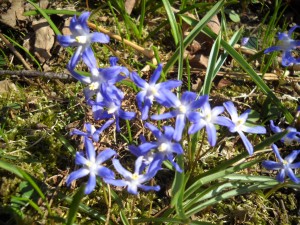
Glory of the snow
Web Extra: Other great bulb plants include Scilla and glory of the snow, both very early blooming. Both are blue to purple, and quite short – 4 inches tall or so. Scilla blossoms look down, while glory of the snow looks up and shows it white and yellow throat. Don’t dismiss them as cut flowers just because they are short – they are available when other things are not.
Winter aconite is lovely, too. This is an early yellow flower that is low to the ground. It has 5 or 6 petals that look up, as bright as any daffodil. It is marginally hardy in my Zone 4 garden, and I seem to lose them some times, but I consider them worth re-planting to keep a small supply going.
Henry’s new book, Wobar and the Quest for the Magic Calumet will be in bookstores October 15. For information about it go to Henry’s Web site, www.Gardening-Guy.com.
 Of course I cut branches of her namesake, Daphne mezereum or February Daphne. It is a fabulous shrub that blooms in May here in Cornish Flat, displaying pinky-purple fragrant flowers in abundance. It is slow-growing, so easy to maintain. No need to do much pruning – other than stems I cut to force in a vase each year in April.
Of course I cut branches of her namesake, Daphne mezereum or February Daphne. It is a fabulous shrub that blooms in May here in Cornish Flat, displaying pinky-purple fragrant flowers in abundance. It is slow-growing, so easy to maintain. No need to do much pruning – other than stems I cut to force in a vase each year in April.

































